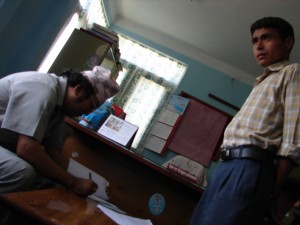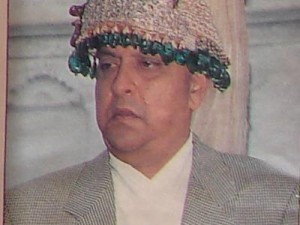Never since the 1950s has Nepal been without elected local bodies for so long. How long has it been? Well, more than a decade. The last local election was held in 1997, and the popular mandate expired back in 2001/02. So it’s been a while! Since King Gyenendra took power in 2002, and continuously under the more recent governments, the local bodies – the DDCs, VDCs, and municipalities – have officially been left to civil servants. In 2008, so-called local multiparty committees were established, but only to serve in an advisory role. They were comprised of the respective local parties and meant to ensure people’s participation in local government. At first, the arrangement of multi-party committees looked like a precursor to local elections. But instead, no elections have been held, and in early 2012 the multi-party committees were even dissolved by the government! Why that decision? Well, the reason was, in on one word: too much corruption!
The local multi-party committees indeed did not confine themselves to an advisory role. In fact, they often influenced the business of running their respective local governments to a high degree and in a corrupt direction. So, it could seem like a very responsible decision to pull the breaks on the local bodies and even postponing elections, couldn’t it? After all, something had to be done about the corruption. Just take irregularities like misappropriation of the budget, allocation of resources based on favouritism, and recruitment guided by nepotism. It was all there. But on the other hand, consider for a moment another also well-known fact in Nepal. The same types of irregularities are just as pervasive at the central level in and around the government and party offices in Kathmandu! So in light of that fact, when misappropriation, favouritism and nepotism are just as widespread in the capital, why come down so hard on the local bodies? Well, the decision did fall naturally in length of a steadily more heated criticism of the local bodies in national media.
In the fall of 2011, reports kept coming in about corruption in the local bodies with calls for action. What did the reports say? Nepali Times, for instance, put it this way. In one of its last articles before the government pulled the breaks on the local bodies, the paper wrote about corruption at local level: “Local governance these days is carried out by what are euphemistically called all-party mechanisms, and they have grabbed the headlines for all the wrong reasons. From small scuffles over the appointment of user committees to fighting over kickbacks in lucrative road and irrigation projects, the mechanisms have a notorious reputation for corruption.” The then Minister of Local Development, Top Bahadur Rayamajhi, listened to the criticism, and in January 2012 he dissolved the local bodies after a CIAA recommendation one week earlier. On the face of it, it was justified! Is there any precedence for justifying such decisions with corruption? Indeed, there is. King Mahendra did it in 1960, and his son, Gyenendra, repeated it as king in 2002. Both decisions were perhaps made with a wish to truly end corruption – we’ll leave that old question open – but let’s go back to the decision by the Minister of Local Development. Was that made out of genuine concern?
Well, what we find a bit puzzling about it is not only the fact that corruption is equally rampant at the central level. It also adds to our curiosity, at least, that local corruption is not a new thing at all. In fact, it was just as pervasive under the elected local bodies in the 1990s and even before that! In fact, the successive governments of the 1990s justified their unwillingness to devolve more power and resources to the local bodies not least in terms of “too much corruption”. Indeed, corruption at local level was decried as much then as it is at present. No doubt, the volume of corruption has increased – more money is being swallowed by it – but mostly for the simple reason that the size of the budgets have grown. There is simply more money to go around! Just take the VDC budget. The annual VDC grant was merely 5 lakh in the late 1990s. Now the budgets of all local bodies are much bigger, on average. Look aside from the volume, however, and the behaviour of corruption is exactly the same. The proclivity of local politicians to misappropriate budgets, favour their “own people”, and arrange things in order to do that, is like it’s always been. Indeed, it was not only rampant corruption in Kathmandu but also in the local bodies that the media complained about also in the 1990s. Or take one of the many research papers from back then, and it’s clear: nothing’s new!
So why the fuzz about local corruption all of a sudden, when it has been going on at local level for ages? Well, perhaps the government pulled the breaks because it truly wished to help ending it. But in light of its next decision, we wonder if that’s the only or even the main reason: local bureaucrats were now left in charge of the local bodies – but is Nepalese bureaucracy then less corrupt than the country’s local politicians? Most would agree that it is not. Countless reports, books and articles say that it’s just as corrupt. Some even say that the bureaucracy has become more corrupt than it was in the past. It’s no secret that misuse of budgets, favouritism and nepotism, were rampant throughout the offices and district agencies of government ministries ever since these institutions were created. It began already in the 1950s and only continued under the Panchayat System and during the elected governments of the 1990s. From the start, taking bribes and commission became a system which undermined the formal rules and regulations, and it still pervades rank of file of the bureaucracy. In short, how can a decision to dissolve the local bodies on grounds of corruption be followed by a decision to put a notoriously corrupt bureaucracy in charge instead? We, at least, find that puzzling.
In the meantime, local people remain left without elected representatives, not only in parliament but also in their local government. We don’t think, not least based on our own observations, that just because the local politicians are elected, corruption will come to an end. Just look around the world and it’s clear that corruption at all levels can easily go hand in hand with popular elections. But if local people would like to have a say in who is to occupy the seats in the local bodies, would it not be fair of a government supposed to represent them to agree? After all, even now locals still turn to their old, long-since suspended Ward Chairman or, say, DDC Member to ask for help. In fact, VDC secretaries often hesitate to make any important decisions without consulting the previous local representatives, simply to avoid getting too unpopular in the communities they work in. It’s not that a Ward Chairman or a DDC Member, elected for one or the other party, truly represent the locals in general. Typically, as is common in Nepal, they tend to serve their own part of the constituency: their own party workers, pockets of voters, even their own family and friends. But they are locals, and they are often perceived by those locals they serve as quite “good” politicians willing to help.
Why, then, leave them out of the picture and centralise control of the local budgets in the hands of the ministries and their officials? Recently, secretaries even started to tour the districts officially to check on the civil servants and the local politicians if some were still interfering. Their objective? To detect and prevent local corruption under their respective ministries. That objective, by the way, is almost humorous if you know how the system of corruption works in Nepalese bureaucracy. For example, it’s part of the old system – still alive – to share bribes and commission amassed at district level with superiors higher up in the ministry. But that’s not the main point we want to make here. The point is, rather, that in light of the pervasiveness of corruption at all levels of Nepalese society, why is it better to allow appointed civil servants, as opposed to local politicians, to run the local bodies? After all, if corruption will continue anyway, can’t local politicians help people a bit more?
Well, let’s consider what local politicians can often do more than civil servants usually can. Local politicians often know a lot more about local needs in their community. They are in touch with local people; they get to know about delays in development projects they might care about; and they can quite often enjoy a great deal of support and legitimacy among some locals. Contrast those qualities for instance with the irregular attendance and even complete absence among some VDC secretaries. Local politicians typically have links to people in their constituencies – to local party workers, teachers, and others – and that enables them to keep abreast with local events and developments, just like they usually live in a part of the community themselves. True enough, many resources will likely go into the pockets of those local supporters for electoral reasons, to meet obligations to relatives or friends, even to just prop up personal income. But some of the resources will also go into development work serving local people. In the 1990s, there was corruption, probably in most DDCs, VDCs and municipalities, but still many roads were constructed and numerous schools built!
There are few saints in Nepal when it comes to corruption. A highly placed official once told us that. He added another aspect: “In a way you can’t blame a single individual. It’s the system and everybody becomes part of it.” So how to understand the decision to exclude local politicians from the local bodies? To sum up: the reason to dissolve the local bodies on grounds of corruption, making it appear as though the government is deeply concerned about this issue, can sound hollow in light of the equally pervasive corruption at central level; and to then put the bureaucracy in charge of the local bodies only seems even more dubious. So, what might be the real motives of the government to dissolve the local bodies? We can only speculate, and perhaps we should. Wonder if the politicians at central level are simply doing the same as Nepali Times once claimed the local politicians are doing. Two years ago, the paper wrote:
“The ‘all-party mechanism’ was set up…to fill the vacuum created after local bodies were dissolved 10 years ago. But the body has become a fertile ground for corruption with the appointees from various parties ‘cooperating’ to divide up allocated budgets.”
What if the whole deal also at central level is all about parties ‘cooperating’ to divide up allocated budgets (and other boons) among themselves, knowing full-well that elections are not immanent, perhaps even trying to delay the timetable for elections as long as possible to maximise their gains? Indeed, if that’s the case, it’s not hard to imagine high-level leaders, even in collusion with top brass of the bureaucracy, dissolving local bodies to keep control of spoils at the local level. But of course, that’s all speculation and we’ll leave it open as such. Indeed, the hallmark of high-level corruption is precisely that few people know about it and even fewer can prove it. In the meantime, what else to do than just wait. Perhaps local elections will still happen one day.
PS: Have an opinion about it? Add a comment and don’t forget to vote in our poll on the need for local elections (see the sidebar).










1 comment
I support local democracy agenda. I found this work very interesting.
Hemant